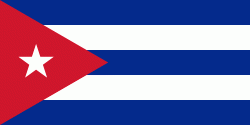Viñales (Municipio de Viñales)
The town and the Viñales Valley immediately to the north were made a UNESCO World Heritage Site in November 1999 for the karst landscape and traditional agriculture as well as vernacular architecture, crafts and music.
Before European settlement, the area was the home of a remnant Taíno population swelled with runaway slaves. The area was colonised at the beginning of the 1800s by tobacco growers from the Canary Islands, who settled in the Vuelta Abajo region. The first colonial settlement in Viñales is documented in 1871, in the form of a ranch belonging to Andrés Hernández Ramos. The town was established in 1878 as a typical community, with church, school, hospital and recreation park.
Map - Viñales (Municipio de Viñales)
Map
Country - Cuba
 |
 |
| Flag of Cuba | |
The territory that is now Cuba was inhabited by the Ciboney people from the 4th millennium BC with the Guanahatabey and Taíno peoples until Spanish colonization in the 15th century. From the 15th century, it was a colony of Spain, and slavery was abolished in 1886, remaining a Spanish colony until the Spanish–American War of 1898, when Cuba was occupied by the United States and gained independence in 1902. In 1940, Cuba implemented a new constitution, but mounting political unrest culminated in a coup in 1952 and the subsequent dictatorship of Fulgencio Batista, which was later overthrown in January 1959 by the 26th of July Movement during the Cuban Revolution, which afterwards established communist rule under the leadership of Fidel Castro. The country was a point of contention during the Cold War between the Soviet Union and the United States, and a nuclear war nearly broke out during the Cuban Missile Crisis of 1962. Following the collapse of the Soviet Union, Cuba faced a severe economic downturn in the 1990s, known as the Special Period. In 2008, Fidel Castro resigned after 49 years of leadership of Cuba and was replaced by his brother Raúl Castro.
Currency / Language
| ISO | Currency | Symbol | Significant figures |
|---|---|---|---|
| CUC | Cuban convertible peso | $ | 2 |
| CUP | Cuban peso | $ | 2 |
| ISO | Language |
|---|---|
| ES | Spanish language |















